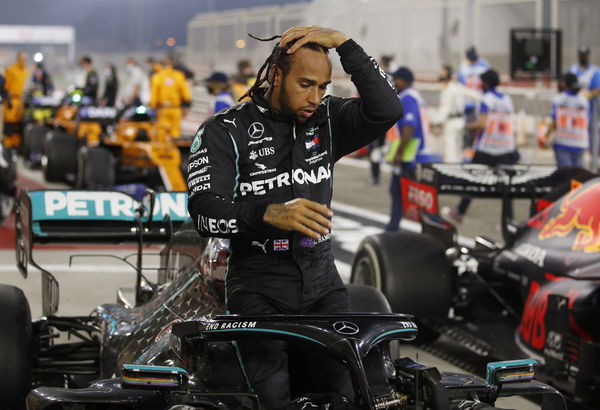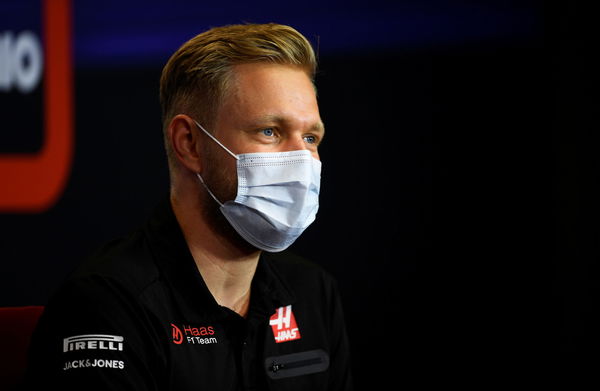
Reuters
Formula One F1 – Abu Dhabi Grand Prix – Yas Marina Circuit, Abu Dhabi, United Arab Emirates – December 13, 2020 Red Bull’s Max Verstappen celebrates winning the race on the podium with second placed Mercedes’ Valtteri Bottas and third placed Mercedes’ Lewis Hamilton Pool via REUTERS/Giuseppe Cacace

Reuters
Formula One F1 – Abu Dhabi Grand Prix – Yas Marina Circuit, Abu Dhabi, United Arab Emirates – December 13, 2020 Red Bull’s Max Verstappen celebrates winning the race on the podium with second placed Mercedes’ Valtteri Bottas and third placed Mercedes’ Lewis Hamilton Pool via REUTERS/Giuseppe Cacace
It is no joke racing in F1 single-seater supercars. The two-hour-long race in a compact place is extremely strenuous for the drivers. The assortment of extreme heat, humidity, and running for 2 hours proves to be a challenging task. In addition, each of them stays under heavy mental pressure to compete with some of the best drivers in the world. The stress of making it to the last lap neatly is a substantial challenge for everyone.
Watch What’s Trending Now!
There are multiple tracks on the current F1 calendar that are extremely taxing on drivers in terms of heat. So much so, that it makes them lose weight. It is not an unknown fact that every F1 driver loses some weight over the course of the race.

Reuters
Formula One F1 – Bahrain Grand Prix – Bahrain International Circuit, Sakhir, Bahrain – November 29, 2020 Mercedes’ Lewis Hamilton celebrates after winning the race Pool via REUTERS/Hamad I Mohammed
All drivers lose around 2 to 3 kilograms in every race. Subsequently, each of them battles extreme dehydration and heat pressure that arises throughout the race. The trainers of the racers help them develop the pattern of their schedule according to the place of the weekend races. Furthermore, the body clock adjusts as per the standard time of the place for the scheduled Grand Prix of the calendar.
ADVERTISEMENT
The trainers make their respective drivers push themselves to such an extent, as to ensure that the driver puts out their best on the track. Singapore is one of the prominent races where drivers often face the toughest challenge of dehydration and sweating, which causes them to lose over 4 kilograms of weight across the race distance.
What’s more, each racer goes through a mental state that equals no less than a rollercoaster ride. The physical discomfort affects the mental state too.
ADVERTISEMENT
Read More: Vomiting, Fainting, and Seeking Ambulance: Qatar GP Unleashed “Hell” on F1 Drivers
Every driver wears several layers of clothing to protect themselves from any accident. The design of the apparel offers to protect the racers from certain dangerous accidents. However, there are certain cons related to it too.
ADVERTISEMENT
The other reasons leading to the weight loss of F1 racers during the race
In every weekend race, racers pass through severe physical challenges to compete. The racers cover themselves in a two-layered fire-resistant attire of gears, an inner suit, and the racing suit on top of it.
Further, to shield their head they wear the balaclava and the crash helmets with visors. Following that, each of them has socks under their racing boots and gloves for their hands. The racers cover themselves from head to toe to protect themselves from disastrous accidents.
ADVERTISEMENT
F1 cockpits on a usual day with palpable weather measure around 45 to 50 degrees Celsius. However, in places with higher humidity and heat, the temperature in the cockpit may soar. While in normal environmental conditions when the cockpit temperature ranges between 40 to 45 degrees, the racer tends to lose up to 2 to 3 kilograms. Whereas, in extreme environmental temperatures, the racer loses around 4 to 4.5 kilograms.
Top Stories
How F1’s 2026 Engine Rules Sound Alarm Bells for NASCAR and Others? – Explained

Max Verstappen’s Siblings: Everything We Know About Victoria, Blue Jaye, Jason Jaxx, and Mila Faye

Despite Jail Threat Looming Over, Helmut Marko Downplays Max Verstappen’s Dangerous $3,500,000 Shenanigans

“Crazy Guy” Fernando Alonso Is Better Than Lewis Hamilton, F1 Pundit Drops Hot Take on Carlos Sainz’s Inspiration

“George Should Be Ashamed of Himself”: Russell’s Delusional Entitlement Infuriates Lewis Hamilton Fans

Although there is a supply of liquids from time to time while racing, that does not match up to the amount of water they lose through perspiration in the boiling environment, which further causes extreme dehydration.

Reuters
Formula One F1 – Portuguese Grand Prix – Algarve International Circuit, Portimao, Portugal – Haas’ Kevin Magnussen during the press conference FIA/Handout via REUTERS
Kevin Magnussen, in 2014, was in an accident that tested his life to a high extent. After the race, Magnussen stated as per ESPN, “It was completely terrible,” he said.
ADVERTISEMENT
“I can’t remember the last half of the race — I was just waiting to blackout. I was so hot and I was overheating, sweating and dehydrated. It was like racing in a very hot sauna.”
WATCH THIS STORY | When F1 Had 7 Different Winners in the First 7 Races of the Season
ADVERTISEMENT
Every racer goes through a process of checking their weight pre and post-racing. Through this process, one can keep track of the weight lost during the session of the race.
(Last updated on Nov, 19, 2023)
ADVERTISEMENT
ADVERTISEMENT
ADVERTISEMENT

